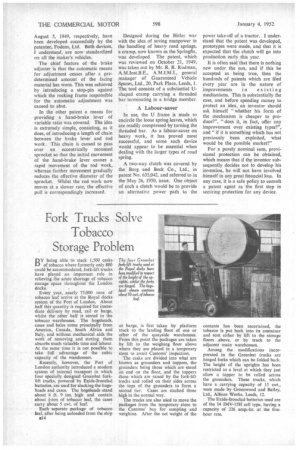Fork Trucks Solve Tobacco Storage Problem
Page 48

If you've noticed an error in this article please click here to report it so we can fix it.
BY being able to stack 1,500 casks of tobacco where formerly only 800 could be accommodated, fork-lift trucks have played an important role in relieving the acute shortage of tobacco storage space throughout the London docks.
Every year, nearly 75,000 tons of tobacco leaf arrive at the Royal docks system of the Port of London. About half this quantity is required for immediate delivery by road, rail or barge, whilst the other half is stored in the tobacco warehouses. The hogsheads, cases and bales come principally from America, Canada, South Africa and Italy, and without mechanical aids the work of removing and storing them absorbs much valuable time and labour. At the same time it is not possible to take full advantage of the cubic capacity of the warehouses.
Recently, however, the Port of London authority introduced a modern system of internal transport in which four specially designed Greenbat forklift trucks, powered by Exide-Ironclad batteries, are used for stacking the hogsheads and cases, The hogsheads stand about 4 ft. 9 ins. high and contain about 1-ton of tobacco leaf, the cases carry about 5 cwt. of leaf.
Each separate package of tobacco leaf, after being unloaded from the ship *314 or barge, is first taken by platform truck to the landing floor of one or other of the quayside warehouses. From this point the packages are taken by lift to the weighing floor above where they are placed in a temporary store to await Customs' inspection.
The casks are divided into what are known as grounders and toppers, the grounders being those which are stood on end on the floor, and the toppers those which are raised by the fork-lift trucks and rolled on their sides across the tops of the grounders to form a second tier. Cases are stacked three high in the normal way.
The trucks are also uied to move the packages from the temporary store to the Customs' bay for sampling and weighing. After the net weight of the contents has been ascertained, the tobacco is put back into its container and sent either by lift to the storage floors above, or by truck to the adjacent main warehouses.
Among the modifications incorporated in the Greenbat trucks are hinged forks which can be folded back. The height of the uprights has been restricted to a level at which they just allow a topper to be rolled across the grounders. These trucks, which have a carrying capacity of 15 cwt., were made by Greenwood and Batley, Ltd., Albion Works, Leeds, 12.
The Exide-Ironclad batteries used are of the 14 IMV-15H cell type, having a capacity of 226 amp..-hr at the fivehour rate.




















































































